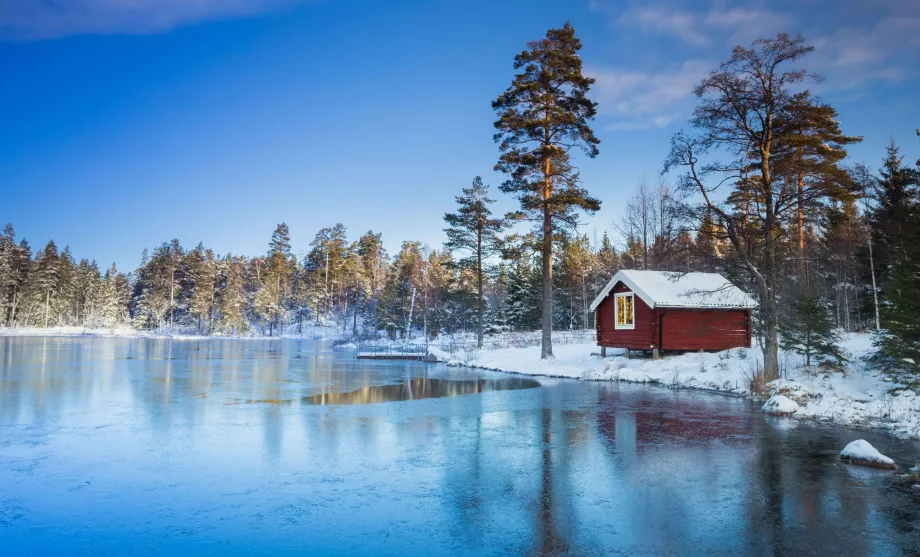Weather in Sweden and best time to go

Despite its northern location, Sweden has a predominantly temperate climate, but temperatures are noticeably lower than in more southern temperate countries such as central Europe or the border region between the USA and Canada.
The Scandinavian mountain range forms a distinct climatic boundary that separates Sweden from the typical oceanic climate of Norway.
The considerable latitudinal range (55-69°N) and the altitudinal variation make the climate within Sweden very diverse. Around 15 % of Sweden lies above the Arctic Circle. The mountains of northern Sweden have a subarctic climate.
North of the Arctic Circle, the sun does not set at all on certain summer days and does not rise at all in winter.
Don't have a hotel yet? Book on booking.com
When is it coldest in Sweden?
Winters are long and can be very cold. Usually the winter weather with frost and snow comes in late November and December and doesn't leave until the end of March. But in the north of Sweden or in the mountains, snow can lie until May.
Frost and snow are common throughout Sweden, but in the south, around Malmö, Gothenburg and Kalmar, the influence of the oceanic climate is more significant and winters are milder than further north.
Thecoldest months are January and February. The average temperatures in these months are as follows:
- Stockholm (central Sweden) - temperatures between -10 °C and +3 °C.
- Malmö (southern Sweden) - temperatures between -8 °C and +5 °C
- Abisko (northern Sweden) - temperatures between -16 °C and -5 °C
Particularly in the Scandinavian mountains and in all northern regions, hard frosts with temperatures below -25 °C can occur.
What are the warmest months in Sweden?
Swedish summers are short and occur between June and August. May and September are also good weather months, but you should only expect spring and autumn temperatures respectively.
During the summer, Sweden attracts travellers who like warm weather, but don't like extreme heat with temperatures over 30°C, which are very rare in Sweden.
- Stockholm (central Sweden) - temperatures between 18 °C and 25 °C
- Malmö (southern Sweden) - temperatures between 18 °C and 25 °C
- Abisko (northern Sweden) - temperatures between 12 °C and 19 °C
When does it snow and rain the most?
Almost all of Sweden lies in the shadow of the Scandinavian mountains, making it one of the least rainy destinations in northern Europe.
Precipitation is spread evenly from about June to December. From January to May, the rainfall is roughly half that.
In Sweden, it snows regularly from the end of November to the end of March, all over the country. However, southern and central Sweden can also experience rain showers in winter and there is considerably less snow than in northern Sweden and in the mountains on the border with Norway.
Rain showers are neither intense nor long. Periods when it rains for several days in a row are not very frequent. There may be several dry days in a row in late winter/early spring or autumn, but the intervals between showers are usually long.
When are the darkest days in Sweden?
Because of its northern location, you can expect very long nights in winter and very long days in summer.
The average sunrise and sunset times for the middle of the month are given below in the detailed weather breakdown during the year.
Table of temperatures during the year
Southern Sweden - From Stockholm to Malmö
Northern Sweden - National parks and the true Swedish countryside
When to go to Sweden
Sweden is beautiful in every season. It just depends on what you prefer and if you don't mind the cold weather.
The best time to go to Sweden for warmth is around the solstice - late June, when the day is longest in Sweden and the midnight sun can be seen in the north.
Winter is at its best in March. It is not so cold anymore and there is still plenty of snow. Plus, in March the day is already long enough to get in plenty of activities even in daylight. But there is also a magical atmosphere in December, when public spaces and private houses are decorated with subtle but very nice Christmas decorations.
The Northern Lights can be seen from mid-September to early April. Of course, the longer the night and the more northerly the location, the more likely it is to be seen.
Compare prices for flights to Sweden
Weather during the year
Here's how the temperatures and day lengths in Sweden look in each month.
Weather in January
January is the coldest month in the whole of Sweden. Temperatures range from -10°C to +3°C in the main populated belt from Stockholm to Gothenburg to Malmö.
In the mountains and northern Sweden, temperatures are on average 5 degrees lower and extremes of up to -26 °C are more common.
Showers are not very frequent and when they do occur, they are usually snow showers. During January, snow cover is common throughout Sweden.
- Sunrise time - 8:30 (Stockholm), 10:30 (Abisko)
- Sunset time - 15:25 (Stockholm), 13:20 (Abisko)
Weather in February
February is a very cold month and winter is still in full effect in Sweden. The precipitation is almost exclusively snow, but it is not very frequent and the totals are rather light.
However, due to the constant sub-zero temperatures (on average between -8 °C and +1 °C), the snow cover is usually at its highest during February, when the snow from previous months does not melt.
The days are short but often sunny and windy.
- Sunrise time - 7:25 (Stockholm), 8:10 (Abisko)
- Sunset time - 16:40 (Stockholm), 15:45 (Abisko)
With the days getting longer towards the end of the month, February-March is the best ski season with a certainty of snow and ample daylight.
Weather in March
During March, snow showers in the south of the country and along the coast are occasionally replaced by rain, but the north (roughly from Umea northwards) is still fully enveloped under a blanket of snow.
Rain or snow showers are infrequent and occur on average 10 days a month. When the weather changes from winter to above freezing temperatures, longer lasting rains (even 2-3 days in a row) can occur.
Normal temperatures in southern Sweden are between -5 °C and +4 °C.
- Sunrise time - 6:05 (Stockholm), 6:05 (Abisko)
- Sunset time - 17:50 (Stockholm), 17:45 (Abisko)
Weather in April
Swedish has a special term for the weather in this month, "Aprilväder", i.e. April weather. This is characterised by very frequent weather changes and frequent strong winds.
During the day, completely clear skies and spring temperatures, heavy rain showers and snowfall with sub-zero temperatures can alternate several times.
Due to the erratic weather, April, like the winter months, is more suitable for visiting cities.
Average temperatures in the southern part of Sweden around Stockholm or Gothenburg oscillate between -2 °C and +8 °C. In the north and in the mountains, the temperature is between -6 °C and +3 °C.
- Sunrise time - 5:30 (Stockholm), 4:50 (Abisko)
- Sunset time - 20:05 (Stockholm), 20:40 (Abisko)
Weather in May
May is the first month that can be described as spring. Temperatures in the south of Sweden rise to an average of 3°C to 12°C, but on sunny days, which are plentiful, they can rise to over 15°C.
Nature is waking up slowly and the first signs are the green lawns in the parks. The leaves on the trees are usually not out until the end of the month.
Snow showers are still quite common in the mountains and in the northernmost parts of Sweden. Otherwise, however, precipitation is light during May and rainfall is only in the form of quick showers.
- Sunrise time - 4:15 (Stockholm), 2:20 (Abisko)
- Sunset time - 21:15 (Stockholm), 23:05 (Abisko)
Weather in June
During June, pure spring temperatures finally arrive in Sweden and if you're lucky, especially in the south around Malmö, but also Stockholm, it can be summer.
Normal daytime temperatures rise to between 16°C and 21°C, with northern and mountainous regions staying between 9°C and 17°C.
The snow is melting in the highest parts of the mountains, making June the ideal first month for hiking, even in the national parks of the far north.
According to statistics, it has rained more since June than in the first months of the year, but these are more likely to be short showers or summer evening thunderstorms. Most of the day has clear or partly cloudy skies.
North of the Arctic Circle you can enjoy the midnight sun throughout June. In June, the sun never sets below the horizon at night.
- Sunrise time - 3:30 a.m. (Stockholm), no sun at all (Abisko)
- Sunset time - 22:05 (Stockholm), the sun doesn't set at all (Abisko)
June is the best month to visit Sweden if you are looking for long days and being outdoors.
Compare prices and buy a ticket to Sweden
Weather in July
July is also a great month for outdoor activities. The weather is summery with mostly partly cloudy skies, and precipitation usually only comes in the form of showers or thunderstorms that don't even last half a day. Moreover, they are far from occurring every day.
Normal temperatures around Stockholm or Gothenburg rise to 24 °C, while in the north around Abisko National Park they stay around 18 °C.
- Sunrise time - 4:00 a.m. (Stockholm), no sunset at all (Abisko)
- Sunset time - 21:50 (Stockholm), no sun at all (Abisko)
Weather in August
August is statistically the hottest month of the year, although the weather and temperatures differ very little from July.
Normal temperatures in southern Sweden are between 20 °C and 25 °C, but they can drop below 15 °C in the evenings or in the rain. In the north, expect temperatures between 11 °C and 18 °C.
August is a fairly heavy month for rainfall, but prolonged showers are rare and you should expect heavy showers on average 5 times a month.
- Sunrise time - 5:05 (Stockholm), 4:00 (Abisko)
- Sunset time - 20:35 (Stockholm), 21:30 (Abisko)
Weather in September
During September, summer ends and autumn begins. However, the weather is still favourable for outdoor excursions, as there is no snow even in the north. It only lies in the highest mountain parts.
Normal temperatures in the mountains and in the north drop between 5 °C and 15 °C, while in the south and in the large cities it is still a very pleasant 13 °C to 17 °C.
The mostly partly cloudy weather is occasionally dampened by an intense, quick shower, but in general rain will not affect your September holiday too much.
- Sunrise time - 6:15 (Stockholm), 6:00 (Abisko)
- Sunset time - 19:05 (Stockholm), 19:15 (Abisko)
Weather in October
Autumn comes to Sweden in full force in October with its crisp weather. However, rainfall totals do not increase compared to summer. The rain is more in the form of showers or light drizzle.
During the day, the weather alternates between partly cloudy and long periods of foggy weather, especially inland and in the mountains.
Nevertheless, October is a beautiful month to visit Sweden, especially because of the richly coloured leaves on the trees, mostly in shades of yellow.
Normal temperatures in the south around Stockholm or Gothenburg are around 9°C. In the north and in the mountains, temperatures drop to between 0 °C and 5 °C and rain can be replaced by snow.
- Sunrise time - 7:30 (Stockholm), 7:50 (Abisko)
- Sunset time - 17:40 (Stockholm), 17:05 (Abisko)
Weather in November
November is a drizzly month. It is often cloudy, although rainfall totals are slightly down compared to summer. Most of the time there is only light drizzle or snow.
Temperatures in the south are between 1 °C and 5 °C, and in northern Sweden the hiking season is long over: temperatures are consistently around -4 °C.
- Sunrise time - 7:40 (Stockholm), 9:00 (Abisko)
- Sunset time - 15:20 (Stockholm), 13:50 (Abisko)
Book a hotel with an off-season discount
Weather in December
December is the darkest month with the least sunshine. During the day, although there are often partly cloudy skies, the days are very short.
Showers are mostly snow, but rainfall totals are not extreme on average.
The average daily temperature in major cities in the south is around 0 °C, while in the north you will encounter values around -7 °C.
The ski season starts in December, but the big resorts may not be 100% sure of snow yet and there is always limited time on the slopes due to the short days.
- Sunrise time - 8:40 (Stockholm), no sunrise at all (Abisko)
- Sunset time - 14:45 (Stockholm), no sunrise at all (Abisko)
Any questions left?
If you have any questions or comments about the article...

